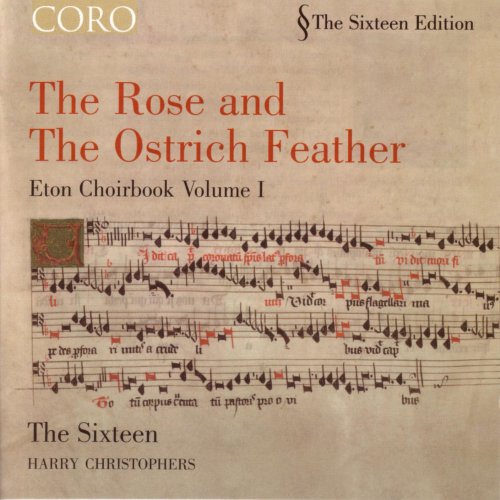
The Sixteen, Harry Christophers - The Rose and The Ostrich Feather: Eton Choirbook Volume I (1990)
BAND/ARTIST: The Sixteen, Harry Christophers
- Title: The Rose and The Ostrich Feather: Eton Choirbook Volume I
- Year Of Release: 1990
- Label: Coro
- Genre: Classical
- Quality: FLAC (tracks)
- Total Time: 01:02:29
- Total Size: 256 Mb
- WebSite: Album Preview
Tracklist:
1. Magnificat ('Regale') 13:27
2. Salve Regina 11:58
3. From Stormy Windes 06:39
4. Stabat Iuxta Christi Crucem 11:04
5. This Day Day Dawes 04:35
6. Salve Regina 14:46
Performers:
The Sixteen
Harry Christophers
1. Magnificat ('Regale') 13:27
2. Salve Regina 11:58
3. From Stormy Windes 06:39
4. Stabat Iuxta Christi Crucem 11:04
5. This Day Day Dawes 04:35
6. Salve Regina 14:46
Performers:
The Sixteen
Harry Christophers
The Rose and the Ostrich Feather, originally issued in 1992, was the first of a series of discs The Sixteen devoted to the Eton Choirbook, a collection of English church music likely copied out in the 1490s. The Sixteen, an expert small English choir, has now reissued these performances on the Coro label along with a variety of other music as part of a "Sixteen Edition." (There are actually 18 group members listed in the jacket material, but who's counting?) For a variety of reasons, this music has remained little known; the lack of a single composer who stands head and shoulders above the rest may be one impedance to the repertoire's popularity.
In any event, The Sixteen give a good account of the music and present it in illuminating ways. Composers represented here include Robert Fayrfax, Richard Hygons, Edmund Turges, John Browne, and William Cornysh; there is one anonymous work. One characteristic of this choral repertoire is that works tend to be big and various, with large musical spaces filled in by constantly moving voice parts. Four of the six pieces here are over ten minutes long. With few sectional markers and little direct connection between music and words, this can make for tough listening for people who like highly structured music, but great stuff for those who like the feeling of having waves of the musical universe wash across them. Another interesting feature of these pieces, and one that will be familiar to listeners interested in Continental music of the same period, is a certain porousness of the boundary between sacred and secular. Worldly potentates are symbolically honored in sacred pieces; the Salve regina of Richard Hygons here contains an early example of the mysterious quotation of a melody attached to the word "caput" (head) in a familiar chant, perhaps symbolizing the role of a king as head of state. Likewise, the anonymous song "This day day dawes," with its reference to a white rose, alluded not only to Elizabeth of York, wife of Henry VII, but also to the Virgin Mary. The ostrich feather of the album's title was the emblem of England's Prince Arthur, to whom Edmund Turges' "From stormy windes" was addressed.
This music may not replace Josquin and Palestrina at the top of the Renaissance hit parade, but The Rose and the Ostrich Feather is hereby recommended to those with an interest in English music, the early Renaissance, or both.
In any event, The Sixteen give a good account of the music and present it in illuminating ways. Composers represented here include Robert Fayrfax, Richard Hygons, Edmund Turges, John Browne, and William Cornysh; there is one anonymous work. One characteristic of this choral repertoire is that works tend to be big and various, with large musical spaces filled in by constantly moving voice parts. Four of the six pieces here are over ten minutes long. With few sectional markers and little direct connection between music and words, this can make for tough listening for people who like highly structured music, but great stuff for those who like the feeling of having waves of the musical universe wash across them. Another interesting feature of these pieces, and one that will be familiar to listeners interested in Continental music of the same period, is a certain porousness of the boundary between sacred and secular. Worldly potentates are symbolically honored in sacred pieces; the Salve regina of Richard Hygons here contains an early example of the mysterious quotation of a melody attached to the word "caput" (head) in a familiar chant, perhaps symbolizing the role of a king as head of state. Likewise, the anonymous song "This day day dawes," with its reference to a white rose, alluded not only to Elizabeth of York, wife of Henry VII, but also to the Virgin Mary. The ostrich feather of the album's title was the emblem of England's Prince Arthur, to whom Edmund Turges' "From stormy windes" was addressed.
This music may not replace Josquin and Palestrina at the top of the Renaissance hit parade, but The Rose and the Ostrich Feather is hereby recommended to those with an interest in English music, the early Renaissance, or both.
DOWNLOAD FROM ISRA.CLOUD
Harry Christophers - The Rose and The Ostrich Feather Eton Choirbook Volume I.rar - 256.7 MB
Harry Christophers - The Rose and The Ostrich Feather Eton Choirbook Volume I.rar - 256.7 MB
As a ISRA.CLOUD's PREMIUM member you will have the following benefits:
- Unlimited high speed downloads
- Download directly without waiting time
- Unlimited parallel downloads
- Support for download accelerators
- No advertising
- Resume broken downloads


